NASA recently announced that two of its astronauts, Butch Wilmore and Suni Williams, will be stranded on the International Space Station (ISS) until at least late March 2025. Originally, the pair was set for an eight-day mission that began in June 2024, using Boeing’s Starliner spacecraft. However, the situation turned complicated due to issues with the Starliner’s propulsion system during their flight. This development forced NASA to rethink their return strategy, leading to an unexpected extension of their time in orbit.
The challenges that emerged highlighted the intricacies of space travel, particularly when relying on untested spacecraft designs. While the Starliner mission was anticipated to be routine, the unanticipated malfunctions serve as a reminder of the uncertainties inherent in space exploration. The decision to abandon the Starliner with its crew aboard in favor of a SpaceX capsule underscored the need for flexibility in mission planning and execution, as well as NASA’s reliance on commercial partners like SpaceX for crew transport.
In a strategic pivot, NASA opted to return Wilmore and Williams to Earth aboard SpaceX’s Crew-9 mission instead of waiting for the troubled Starliner to become operational. Crew-9 had been docked at the ISS since late September 2024, providing an opportunity for a hastened return for the stranded astronauts. Both astronauts were expected to fly back with Crew-9’s crew, but they will now wait until late March due to delays in the Crew-10 launch, which will replace Crew-9.
The continued presence of Wilmore and Williams on the ISS reveals the operational challenges NASA faces in maintaining a steady rotation of crews aboard the orbiting laboratory. Each delay compounds the discomfort and fatigue experienced by astronauts, who are now set to spend more time in space than originally intended. This unplanned extension could affect their physical and psychological well-being, a critical area of focus for NASA.
Safety and Preparedness in Space Operations
NASA’s recent blog post detailing the changes stressed that the delay allows the agency and SpaceX time to finalize the preparation of a new Dragon spacecraft intended for Crew-10. Safety remains a top priority; the time taken helps ensure that all systems are go for a successful mission. However, this raises questions about the robustness of the existing schedules and the dependency on primarily commercial partnerships for transportation to the ISS.
Elon Musk’s SpaceX has carved out a significant niche in commercial space travel, regularly conducting missions every six months. Yet, the pressure of maintaining operational consistency while dealing with unforeseen challenges showcases the significant hurdles in the private space industry—especially when lives are at stake. The extended mission duration for Wilmore and Williams will cross the nine-month mark, a significant period for astronauts accustomed to shorter missions.
As Wilmore and Williams prepare for more time in space, their overall adjustment to the extended mission will be paramount for the success of future operations. Their journey underscores the unpredictability of space exploration, where plans may evolve rapidly based on unforeseen technical challenges. NASA will need to enhance its contingency planning to account for potential issues, ensuring that astronauts can safely complete their missions. The need for adaptability in the face of adversity has never been more pronounced in the world of extraterrestrial exploration.


Leave a Reply